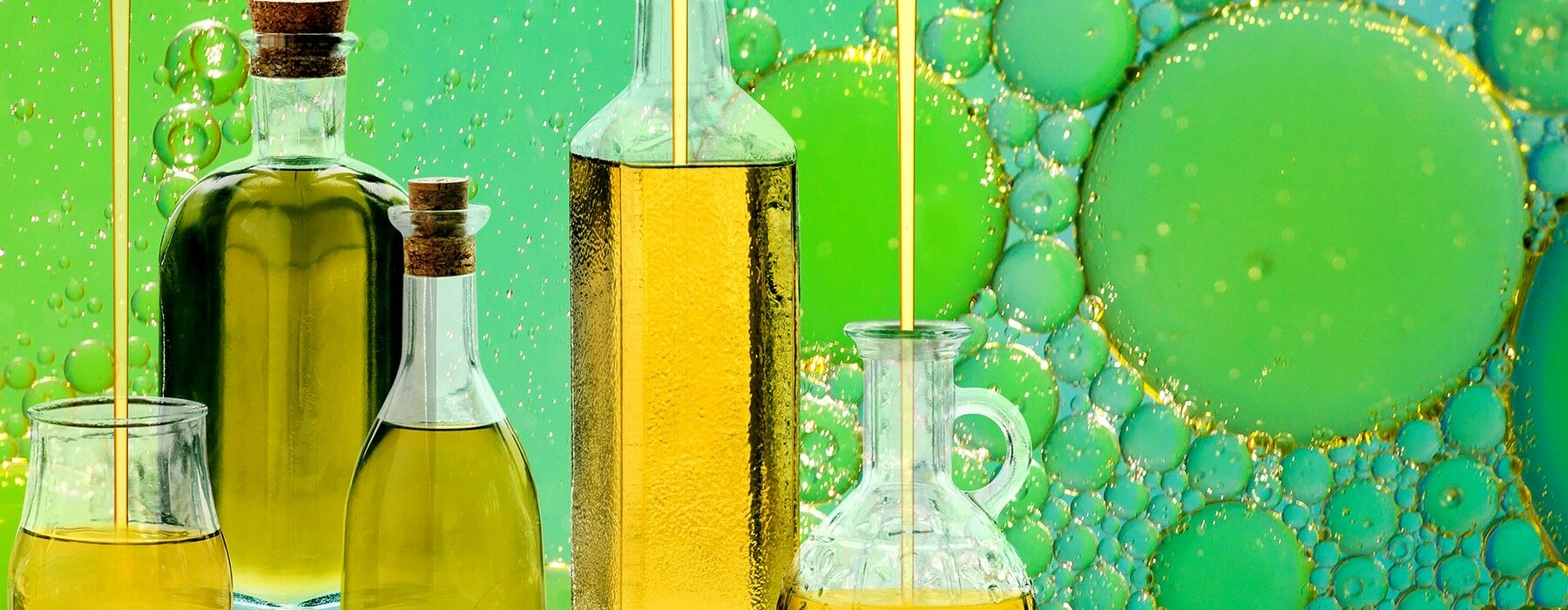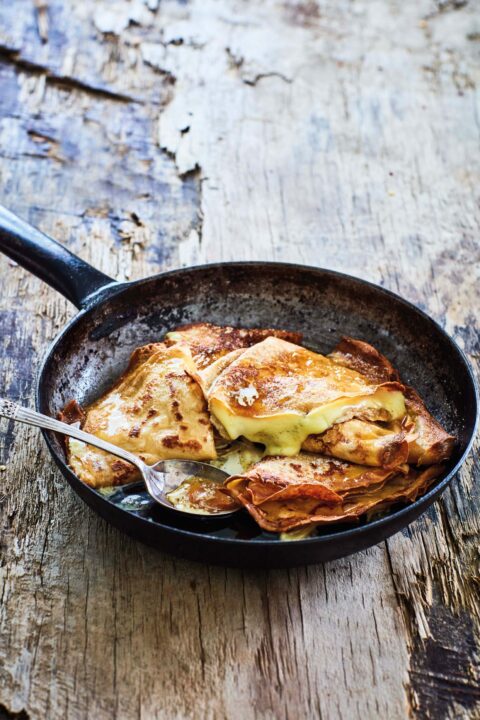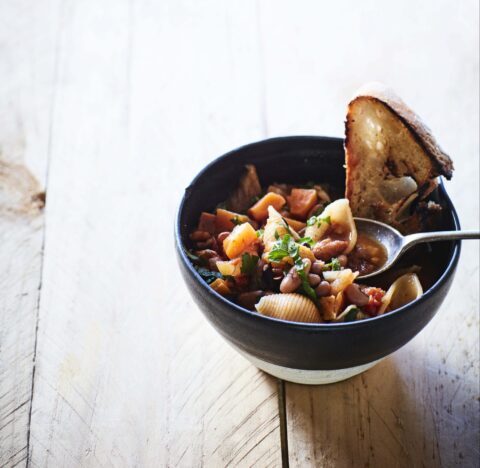Feeling dazed and confused by the bottles and bottles of different cooking oils in the supermarket aisle? Rachel Clare demystifies the world of plant oils, from fat profiles to smoke points.
There are so many cooking oils available these days that they end up taking up a lot of real estate in our kitchens, and it can feel as if you need to do a workshop in order to know which ones to use. To start with, all plant oils are 100 percent fat, and while we’ve been conditioned into thinking that “fat” means bad, we actually need a certain amount of fat in our diet to give us energy, support cell function, absorb nutrients and stay warm. In fact, plants make oils because they need energy too.
What’s important is that oils contain varying amounts of “good” fat and “bad” fat depending on their plant source, and the processes used to extract it. All plant oils contain a mixture of monounsaturated, polyunsaturated and saturated fat. The goodies are monounsaturated and polyunsaturated fats; saturated fat is less desirable to have in our diets. Regardless of their fat profile, all cooking oils contain 13-14g of total fat per tablespoon.
Saturated fats are mainly found in animal-based products such as meat and butter. They have been linked with a higher risk of heart disease. Apart from coconut oil, which is around 90 percent saturated fat, most plant oils contain only around 10-20 percent saturated fat.
The rest of their fat content is healthy monounsaturated and polyunsaturated fats. Monounsaturated fats increase the good kind of cholesterol – called high-density lipoprotein (HDL) – and are good for heart health and cell regeneration. Polyunsaturated fats are made up of omega-3 and omega-6 fatty acids, which help with brain function and cell growth. They can be found in oily fish and in nuts and seeds.
Oil origin stories
Cooking oils can be made from fruit, seeds or nuts and are generally made three ways. Cold-pressed oils are mechanically pressed, or spun in a centrifuge machine, without using heat, giving them strong natural flavours and higher health properties. “Extra virgin” oils are the highest quality cold-pressed oils because they are made from the first pressing. Hot pressed oilsare extracted using high pressure, which creates heat or, in the case of seed oils, the seeds are roasted and then pressed. Refined oils are made using chemicals; solvents are used to remove the oil, then the oil is purified, bleached and deodorised. This process, often used for sunflower, canola and soybean oil, results in oils that last longer and have higher smoke points.
What is a smoke point?
Heating an oil alters its chemical make-up. It’s important not to heat oils beyond their “smoke point” – the temperature at which they start to burn – so that they don’t lose flavour, antioxidants and beneficial essential fatty acids, and to prevent them from releasing harmful free radicals. Oils have different smoke points. A refined oil will have a higher smoke point than its virgin counterpart, so you might use a roasted sesame oil for cooking at a high heat but a virgin sesame oil for a salad dressing.
Oils with high smoke points (above 200°C) that are suitable for stir-frying and sautéing include olive, canola, grapeseed, peanut, sunflower, safflower, avocado and refined coconut.
Oils with low smoke points (below 175°C) that shouldn’t be heated but are suitable for salad dressing, pestos and dips include unrefined coconut, flaxseed and hemp.
How to store oils
Cold-pressed oils are light sensitive, which is why many of them come in dark-coloured bottles. Store them in a cool, dark place to prevent them from oxidising and tasting rancid, keep the lid screwed on, and use them within 12 months.
Which oils are best for the planet?
Plant-based oils are better for the planet compared with animal fats, due to the heavy environmental impact of farming. However,the popularity of cooking oils has led to over-intensification of plant crops. In Spain, olive groves account for more than 70 percent of cultivated land, and have caused soil erosion, a lack of diversity of other plant species and depletion of water resources through irrigation. The best thing you can do if you want a planet-friendly oil is to buy local. New Zealand olive oils, including organic options, are available in supermarkets. We also produce hemp seed oil here, and Canterbury company The Good Oil turns fields of locally grown rapeseed and Provence-aspirational golden sunflowers into its cold-pressed oils.
Types of oils
Avocado
Made from the pulp of ripe avocados, avocado oil is high in healthy oleicacid, a monounsaturated omega-9 fatty acid, and vitamin E and has a very high smoke point. Its nutty, grassy mild avocado flavour also makes it ideal for salad dressings, marinades, sauces and dips.
Grapeseed
A by-product of winemaking after the grapes have been pressed, grapeseed oil has a very high smoke point, making it ideal for frying. It also has a neutral flavour so can be used in baking without affecting the flavour. It is high in linolenic acid (omega-3), which is often used in skincare because it can be easily spread onto the skin but leaves no oily residue.
Sesame
A staple of Asian dishes, sesame oil has a nutty, aromatic flavour and can be used at a high heat when refined.
Sunflower
This oil, made from the seeds of sunflowers, is high in polyunsaturated fat and one tablespoon is said to provide 28 percent of daily vitamin E requirements. Be aware that it contains high amounts of omega-6 fatty acids, which we need for good health, but we also need to balance these out with plenty of omega-3 oils, so make sure you’re including both in your diet. Sunflower oil is widely used for frying, particularly for fast food, and has a mild flavour.
Olive
Widely considered the most healthy oil and the poster child of the Mediterranean diet, oil made from olives is rich in antioxidants and vitamin E and is 75 percent monounsaturated fat. Extra virgin olive oil is the best because it’s the least processed – essentially it’s olive juice! Going down through the grades, virgin olive oil (sans the extra) is extra virgin with minor imperfections, whereas pure olive oil is a mix of virgin olive oil plus olive oil that has been refined. Although some olive oils are labelled “light” or “extra light”, this refers to the colour and flavour rather than the amount of fat.
Safflower
Originating from the seed of a plant that looks like a pretty yellow thistle, safflower oil contains the least saturated fat of any widely available plant oil and the most monounsaturated fat of any oil. It has a mild, neutral flavour and a high smoke point when refined. It can also be applied topically to inflamed skin and is used in cosmetics.
Peanut
Unsurprisingly, peanut oil has a slightly nutty flavour but is mild-tasting enough that it won’t taint the flavours of other foods. It has a high smoke point so is widely used for deep frying and has one of the highest monounsaturated fat contents of all cooking oils.
Canola/rapeseed
Low in saturated fat, rapeseed/canola oil is extracted from the seed of the canola family, which belongs to the same family as brassicas (like broccoli and cabbage). It is one of Canada’s main crops and the name canola is a contraction of Canada and oil. It has received some bad press, with suggestions that it releases unhealthy compounds at high heat, but current evidence is that it’s heart-healthy, and using it for shallow-frying in a home kitchen poses no health risk.
Soybean
One of the most common cooking oils in the world due to its high smoke point and neutral flavour, soybean oil is extracted from the seeds of the soybean plant. It’s high in polyunsaturated fat and vitamin K, which is good for bone and heart health. However, it’s high in omega-6 fats without a good balance of omega-3s, so it’s best used in moderation along with other oils.
Rice bran
A byproduct of rice milling, rice bran oil is made from the outer layer of the rice kernel. It contains more unsaturated fat and is packed with vitamin E. It has an earthy flavour and a high smoke point, making it suitable for high-temperature cooking.
Macadamia
With a buttery taste and a high smoke point, macadamia nut oil contains antioxidants and vitamin E. It can also be applied directly to the skin.
Hemp seed
Rich in omega-3, hemp oil comes from the seeds of the hemp plant (you can’t get high from it because it comes from food-grade strains of the cannabis plant). Use it for drizzling over food or in pestos or vinaigrettes rather than cooking, as it burns at a low heat. It can also be used in skincare, and a 2014 study showed that it made skin more resistant to infection.
Flaxseed
Different from harakeke (our native flax), flaxseed oil comes from the linseed plant but is extracted in a different way from linseed oil that’s used for staining wood. It is very high in omega-3 but breaks down quickly under heat and shouldn’t be used for cooking. Instead, use it for salad dressings and dips.
Vegetable
A combination of different plant oils, vegetable oils in New Zealand tend to be a mix of canola and sunflower oil or soybean and canola, and have a neutral flavour.
Is coconut oil really healthy?
Coconut oil became the subject of controversy in 2018 when a Harvard epidemiologist called it “pure poison” in a talk entitled “Coconut oil and other nutritional errors” that went viral (and is no longer online) on YouTube. This was after it had been touted as a health food by the likes of celebrities such as Gwyneth Paltrow. The issue was around the fact that it contains more than 90 percent saturated fat – more than butter. However, while the Ministry of Health’s guidelines advise that it is better than butter for HDL cholesterol, it recommends using oils that are lower in saturated fat, as does the Heart Foundation.
Coconut oil is a staple in many countries, such as the Philippines and India, but in its guidelines for healthy eating, published in 2020, the ministry advised: “The Heart Foundation considers that when indigenous people consume coconut flesh and milk along with fish and vegetables, and they are also physically active, the coconut consumption is unlikely to put them at risk of cardiovascular disease. They are in a very different situation from people who consume coconut oil along with a typical Western diet.”
Additionally, some nutritionists have suggested that coconut oil could be a good option for vegans, as it might provide saturated fatty acids that they might otherwise miss out on.








